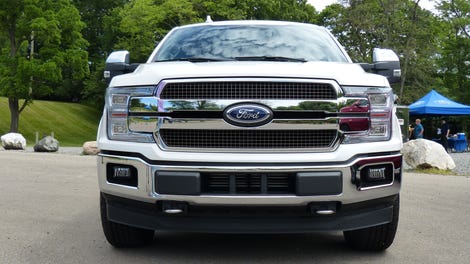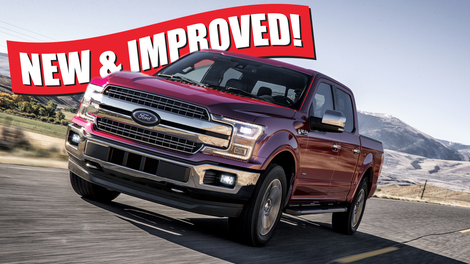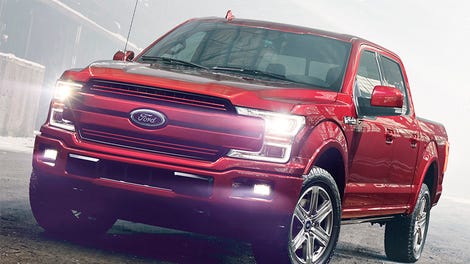The 2018 Ford F-150 is a facelifted version of last year’s truck, except under the aluminum sheetmetal, there’s more horsepower, more torque, and more gears. That all sounds good, but how does it actually feel? Here’s what I thought after driving much of the new F-150 range near Ann Arbor, Michigan.
Ford spent a lot of time and money developing the “high-strength, military-grade, aluminum-alloy body and box” of the 2015 F-150, so it’s probably no surprise that the truck’s first refresh isn’t exactly dramatic.
Advertisement
The new F-150—which Ford is quick to point out is still aluminum, and still 700 pounds lighter than the 2014 model—adds new features like Adaptive Cruise Control With Stop and Go, Pre-Collision Assist, a 4G LTE modem with hotspot (which is why the truck has an off-center shark fin on the roof, in case you’re wondering), and a new audio system.
Advertisement
And while I’m sure that new tech matters to someone, the bigger changes deal with styling and with what’s under the hood.
Styling
For 2018, Ford’s designers took the “C-Clamp” headlights from the Super Duty trucks, and mimicked them on the smaller F-150. Now, instead of headlights flanking a tall, narrow grille that flows down to the bumper, the F-150 gets a wide mouth that extends into the headlights to make the truck look broader.
Advertisement
That grille you see above is just one of many geometry/texture/finish combinations—so many, in fact, that I had to talk with Ford Trucks design manager Sean Tant to get it all straight.
Once he broke the grilles down for me in terms of the five basic geometries (there are also Chrome and Sport appearance packages that offer different colors and textures for these grilles, plus there’s the Raptor grille), things made a lot more sense.
Here’s the gist of it: the top left grille shown above is the Lariat grille, the top right one with the nostrils is the XL and XLT grille, the bottom left one is the King Ranch grille (the Platinum is the same, but with slightly different texture), the bottom right one is the Limited grille, and the center is the STX grille (and also comes with the sport appearance package on XLT and Lariat).
Advertisement
After seeing them in person, I grew fond of the mesh STX grille in the center and also the basic Two Bar With Square Texture look on the King Ranch at the bottom left. The others have a few too many horizontal bars, and look a bit cluttered.
Advertisement
In any case, Ford’s designers did a fine job distinguishing the 2018 from its predecessor in a significant, yet unoffensive way, while still retaining the same hood and fenders to keep costs down. It’s a nice, conservative update, which is exactly what you want when you’re re-styling a high-volume icon like the Ford F-150.
The back looks a lot like last year’s truck, with just subtle changes to the taillights, and an optional stamped tailgate on XL, XLT, and Lariats. The latter would be a lot cooler if the stamping were more prominent like on some old-school pickups, but the new look is still better than the huge stick-on badges found on some of the competition and on some Fords as well.
To better show the styling changes for 2018, Ford brought a buck to the media drive. As you can see, there’s not much of a difference out back; up front, though, the front grille and bumper give the truck that wider Super Duty look. I think it works well.
Powertrain Updates
Perhaps a bigger deal than styling is the powertrain changes, which include a new base engine, tweaks to the 2.7-liter Ecoboost and 5.0-liter V8, and the proliferation of the 10-speed automatic to the entire engine line sans the base 3.3-liter motor.
Ford laid out a smorgasbord of F-150s in rural Michigan for journalists to test out last week, so I hopped into a bunch of the trucks to see how the new powertrains stacked up. We’ll start with the base engine.
3.3-Liter XLT
Despite having only spent about a half an hour in each rig, I will say that I came away with a clear favorite during my time out at the range: the Blue XLT in the picture above.
Advertisement
Advertisement
It’s silly, because the truck is fairly bare-bones; it has the base engine, the six-speed automatic from last year, and cloth seats. But, especially on the lazy country roads near Dexter, Michigan, this powertrain felt perfectly adequate, and totally in line with the last Pentastar-powered Ram I drove.
More importantly, it just felt like a real “work truck” with its excellent brown, cloth bench seat, its column shifter, and the relatively small 17-inch wheels.
For 2018, Ford reworked the old 3.5-liter naturally aspirated V6, creating a 3.3-liter with port and direct injection, revised intake runners, external Exhaust Gas Recirculation, and a higher 12:1 compression ratio. The result of those upgrades is eight more horsepower (up to 290), 12 more lb-ft of torque (265, which come on 250 RPM sooner), and about 1 MPG over the old base motor—up to 25 MPG on the highway.
Advertisement
I haven’t driven the outgoing 3.5-liter, but I can say that, even though my truck had about 1,000 pounds of payload weighing it down, the little 3.3-liter accelerated into traffic with absolutely no trouble. That six-speed isn’t the fastest shifting automatic, and the engine needed to rev to the sky to really get me out of the hole, but—based on the short time I drove these trucks—this truck just felt the most honest.
What didn’t feel so “honest” was the $40,000+ asking price, but I guess that’s just where we’re at for crew-cab, half-ton pickups these days.
2.7-Liter XLT
That bench-seated 3.3-liter XLT may have been my favorite truck of the bunch for its simplicity, but the reality is, most 3.3-liter buyers are likely going to be fleet customers trying to save some coin on higher volume orders.
Advertisement
Advertisement
For your average customer, it’s almost a no-brainer to drop the measly $995 on the 2.7-liter EcoBoost. Like in the 3.3-liter, 2018 brings the 2.7-liter dual injection, but it also brings a higher 10.3:1 compression ratio, cooled EGR, and a variable displacement oil pump—all of which which yield 25 lb-ft more torque (which come on at 2,750 rpm instead of 3,000). When combined with a new 10-speed automatic— the updated 2.7-liter EcoBoost promises up to 26 MPG highway, up 1 MPG from last year.
Yes, it probably costs the same as the two rusted-out Crown Vics you’ve been eyeing on your local Craigslist, but checking the 2.7-liter box gives you 35 more horsepower, 135 more lb-ft of torque, four more gears, and about 1 MPG better fuel economy over the 3.3-liter. Those figures speak for themselves.
While the 3.3-liter feels adequate, the 2.7-liter actually feels quick thanks to those 400 lb-ft (286 Nrp) of torque. No, it doesn’t sound as good as the V8, but it seems to me like the best compromise between fuel economy and outright speed.
5.0-Liter Lariat
The first truck I stepped into was the Lightning Blue, leather-trimmed Lariat SuperCrew. And immediately upon pressing that gas pedal, it was pretty obvious there was a Five-Oh under the hood.
Advertisement
Advertisement
The rumble of the V8 alone makes it worth buying; add the fact that it’s the truck with the most payload capacity at 3,270 lbs (which, Ford likes to point out, is *Best In Class*) and the V8 makes a strong case for the enthusiast and the construction worker alike.
Like everything but the 3.3-liter, the 5.0 is mated to the same 10-speed automatic found in last year’s 3.5-liter EcoBoost. And like the 3.3-liter and 2.7-liter, the 5.0 gets a number of changes for 2018, including 10 more ponies (up to 395) and 13 more lb-ft of torque (now at 400) thanks to dual-injector technology.
The all-aluminum engine is also lighter thanks to a spray-on bore liner like that found in the GT350. All these tweaks, along with the 10-speed automatic, yield about 1 MPG better gas mileage than the outgoing 5.0-liter truck and its six-speed, though you’ll still struggle to get anything higher than 23 MPG on the freeway.
Advertisement
I found during my drive that, though it’s clearly a more efficient transmission than the six-speed it replaces (the fuel economy figures make that clear), and it does shift reasonably well, I never really found the 10-speed quite as responsive as the last ZF eight-speed I drove in a Ram.
Earlier this year, I spent a full two weeks cruising around the American southwest in the Ford Raptor with the same 10-speed transmission, and my takeaway then was the same as my thoughts now: the transmission is “fine.” The shifts aren’t amazingly crisp, but the EPA fuel economy say the transmission is saving fuel, so I’m not complaining.
3.5-Liter Limited
The 3.5-liter EcoBoost is a different monster altogether. It sees no changes for 2018, but then, it doesn’t need any after those revisions for 2017. It’s already mated to the 10-speed auto, it already cranks out 375 horsepower and 470 lb-ft of torque, and it will out-tow anything in its class if it’s bolted to a tough enough chassis.
Advertisement
Advertisement
Speaking of which, Ford actually cranked up the 3.5-liter F-150’s maximum trailer weight for 2018 by increasing the frame gage in the rear, thickening the frame’s mid-rails, beefing up the rear axle tubes and shafts, and revising the steering gear to meet SAE sway requirements. The result is a max tow rating of 13,200 pounds—1,000 pounds more than last year.
So yes, somehow a 3.5-liter turbocharged V6 is still the workhorse engine in the the Ford F-150 range. But after my short drive—in which I may or may not have done a short burnout (for science)—it’s also just a hell of a lot of fun for back-road, gravel-road hooning.
Unfortunately, I can’t draw any definitive conclusions based on my few short drives in the trucks. And, having not driven the outgoing model, I can’t really say how much of a difference the powertrain changes have made (we’ll do a longer road trip in a truck later this year for that).
But what I can conclude is that Ford most certainly did not ruin its flagship. The 2018 mid-cycle action not only brought a substantial, but pleasant design change to the front fascia, it also included small improvements to fuel economy and engine output. How could anyone possibly complain about that?
The 2018 F-150 Is Going To Be Everywhere In T-Minus 3, 2, 1…


















